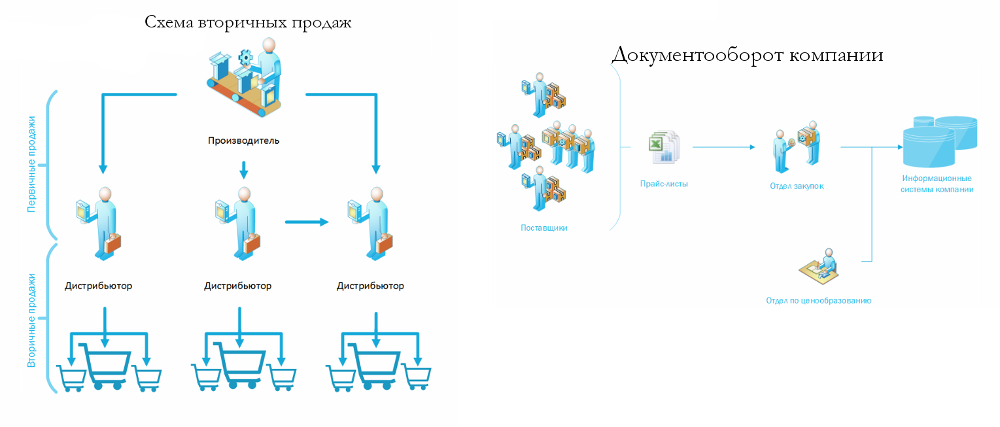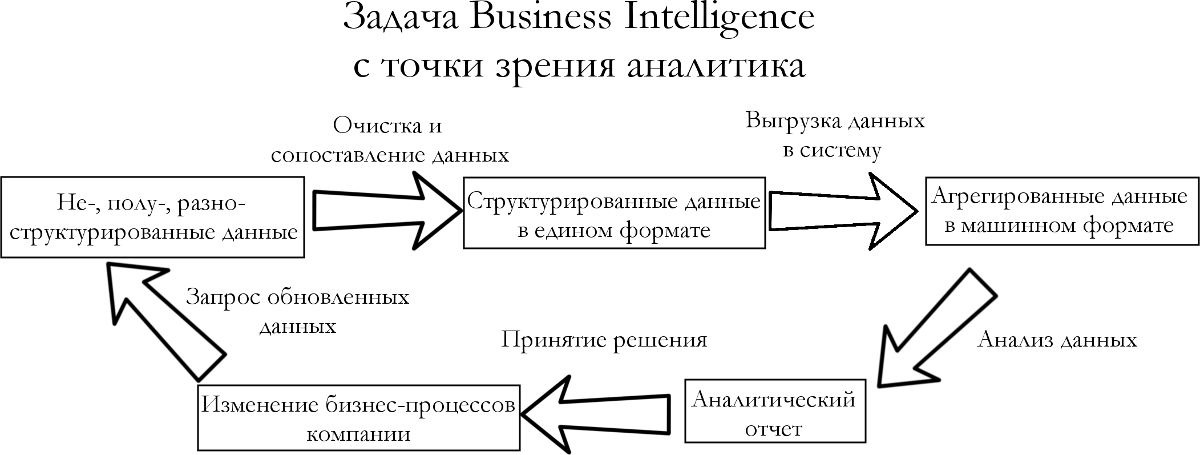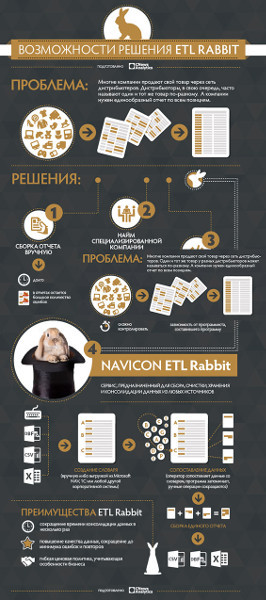What is Business Intelligence?
There are a huge number of terms: analytics, data mining, data analysis, business intelligence and the difference between them is not always so obvious even for people who are associated with it. Today we will talk about what is Business Intelligence (BI) in an accessible and understandable language. The topic is unconditionally huge and not covered by just one short article, but our task is to help take the first step and interest the reader in the topic. The interested reader will also find an exhaustive list for further steps.
Article structure

')
Imagine, we (some analyst Petrovich at the supplier Flower) have the task to evaluate the sales of a number of stores (where we deliver the goods) and each store keeps its own record of goods sold. The reality is that accounting forms will be filled out, do not understand, and neither do they understand, that is, they will have a different structure and a different storage format (some form of tables). Schematically, this task is depicted in the diagram above.
It would seem that the task is simple and therefore consider a head-on solution: let us have N tables and we need to put them together in one table, then we write N scripts that convert these tables and one collector who assembles them together.
Cons of this approach:
If we rise to the level of the whole organization, we will see that there are even more problems.
(clickable)

Flower maker actually works not directly with stores, but through some intermediaries. Intermediaries visit stores and directly by their actions try to stimulate sales. Accordingly, they are financially interested persons and the information they give out has to be rechecked.
Basically, the task looks the same: let us have N stores and K distributors, can we aggregate the store data and compare them with the results of distributors? (All data have a different structure and format.)
Here, in addition to the tables, we can already encounter a whole zoo of formats, to which the reports of distributors are added. As a rule, a task is characterized by very low data quality, including duplication, inconsistency and errors. Based on the obtained results and data comparison, the purchasing department makes decisions about how much, to whom and why to ship. That is, the solution of this problem directly affects the financial performance of the company, which is certainly important.
Consider several solutions at the company level:
In general, if we are talking about a small or medium producer, then from the point of view of integration time, price and quality of the solution, the service looks like the best option, since the pricing is dynamic and integration is minimal via the web. As a rule, an advantage of corporate software is customizability and kasmtomization (each business considers itself unique), but the task described is fairly typical and standard for a fairly wide range of companies. Of course, there is no one solution for everyone, but for everyone it can be found.
More on the topic here .
The process itself at the company level looks the same way: data is consolidated, transformed in a certain way (aggregated) and loaded into the system for analysis.
(clickable)

(clickable)

What is the difference between analytics, data mining and business intelligence (BI)? The first include a set of methods for analyzing already clean data, but in practice, cleaning and transforming data into an easy-to-analyze format is an important and integral process. Also, in addition to working with data transformation and consolidation, the main task of BI is making decisions for business.
In a schematic and slightly simplified form, the task of data consolidation is described. If it is not possible to study the topic in detail, then this infographic gives a good first approximation of the problem and possible solutions. (clickable; taken from here )

(clickable)

The service is free and available through a web link .
Article structure
- Why all this is needed: from the life of the analyst
- What is the problem: the problem at the company level
- We generalize the problem: all these are links of one chain
- Big infographics
- What you can experiment with
- What to read? Must read by Business Intelligence
Why all this is needed: from the life of the analyst
(clickable)
')
Imagine, we (some analyst Petrovich at the supplier Flower) have the task to evaluate the sales of a number of stores (where we deliver the goods) and each store keeps its own record of goods sold. The reality is that accounting forms will be filled out, do not understand, and neither do they understand, that is, they will have a different structure and a different storage format (some form of tables). Schematically, this task is depicted in the diagram above.
It would seem that the task is simple and therefore consider a head-on solution: let us have N tables and we need to put them together in one table, then we write N scripts that convert these tables and one collector who assembles them together.
Cons of this approach:
- it is necessary to support N scripts simultaneously (where N is in the order of thousands);
- when changing the structure of store reports in time (for example, a new employee has appeared in the store) it is necessary to search and rewrite individual scripts;
- when a new store appears, you need to write a new script;
- when changing our reporting (supplier Flower), you need to make changes to all scripts;
- complex debugging and support, as the stores do not notify about the restructuring and do not follow any specifications.
If we rise to the level of the whole organization, we will see that there are even more problems.
What is the problem: the problem at the company level
(clickable)

Flower maker actually works not directly with stores, but through some intermediaries. Intermediaries visit stores and directly by their actions try to stimulate sales. Accordingly, they are financially interested persons and the information they give out has to be rechecked.
Basically, the task looks the same: let us have N stores and K distributors, can we aggregate the store data and compare them with the results of distributors? (All data have a different structure and format.)
Here, in addition to the tables, we can already encounter a whole zoo of formats, to which the reports of distributors are added. As a rule, a task is characterized by very low data quality, including duplication, inconsistency and errors. Based on the obtained results and data comparison, the purchasing department makes decisions about how much, to whom and why to ship. That is, the solution of this problem directly affects the financial performance of the company, which is certainly important.
Consider several solutions at the company level:
- Self-written solution: the manufacturer will need to hire a specialist not in the company's profile and critical software will depend on the specialist. If he leaves, the company will be forced to urgently look for a replacement that will be able to maintain the software and the quality will depend directly on the hired specialist;
- buy software from a third party, there are three key factors: price, quality and integration time. As a rule, the price and time of integration are too high for the average manufacturer, including the time-consuming staff. Choosing a supplier is also not trivial;
- SaaS solutions: the methodology is still new to the market and many companies are skeptical about such services.
In general, if we are talking about a small or medium producer, then from the point of view of integration time, price and quality of the solution, the service looks like the best option, since the pricing is dynamic and integration is minimal via the web. As a rule, an advantage of corporate software is customizability and kasmtomization (each business considers itself unique), but the task described is fairly typical and standard for a fairly wide range of companies. Of course, there is no one solution for everyone, but for everyone it can be found.
More on the topic here .
The process itself at the company level looks the same way: data is consolidated, transformed in a certain way (aggregated) and loaded into the system for analysis.
(clickable)

We generalize the problem: all these are links of one chain
(clickable)

What is the difference between analytics, data mining and business intelligence (BI)? The first include a set of methods for analyzing already clean data, but in practice, cleaning and transforming data into an easy-to-analyze format is an important and integral process. Also, in addition to working with data transformation and consolidation, the main task of BI is making decisions for business.
Big infographics
In a schematic and slightly simplified form, the task of data consolidation is described. If it is not possible to study the topic in detail, then this infographic gives a good first approximation of the problem and possible solutions. (clickable; taken from here )

What you can experiment with
(clickable)

The service is free and available through a web link .
What to read? Must read by Business Intelligence
Source: https://habr.com/ru/post/250875/
All Articles